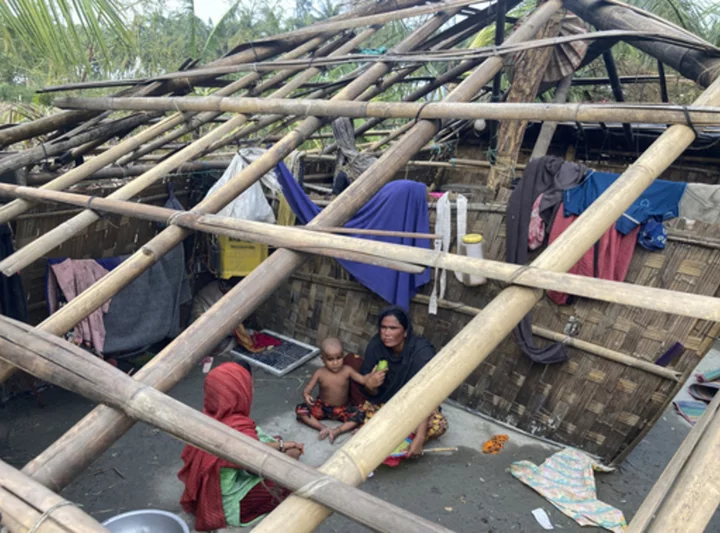DHAKA, Bangladesh (AP) — Early warnings from weather agencies and better preparedness by local governments and aid agencies likely saved thousands of lives during a powerful cyclone that slammed into Bangladesh and Myanmar over the weekend. But there are concerns about a large number of people still unaccounted for in areas where preparations were lacking.
At the world’s largest refugee camp in Bangladesh's Cox’s Bazar district, thousands of Rohingya from Myanmar were moved to safer areas until Cyclone Mocha passed. But at camps for displaced Rohingya in Myanmar's Rakhine state, where the storm hit harder, the presence of aid agencies is spotty and help from the country's military government negligible.
Only about two dozen deaths have been reported by media in Myanmar, but many people remain missing from the camps, which were reportedly heavily damaged by storm surges. Information from the affected areas has been hard to obtain because telecommunication facilities were damaged by the storm's high winds. Independent confirmation is difficult even in normal times because the military restricts the media.
In Bangladesh, Prime Minister Sheikh Hasina said more than 700,000 people were moved to cyclone shelters or makeshift facilities including schools and mosques.
Azizur Rahman, director of the Bangladesh Meteorological Department, said early warnings and “proper and timely dissemination of information” enabled authorities to move people to safer ground in time.
India’s weather agency, the Indian Meteorological Department, closely tracked the storm after it was detected on April 27. As the leading weather agency in the region, the IMD is responsible for tracking cyclones across the Northern Indian Ocean, from the shores of Oman in West Asia to Myanmar in Southeast Asia.
Since 2010, it has upgraded its storm-tracking technology and is now among the most accurate forecasters of cyclones and other extreme weather events.
“When Cyclone Nargis, a storm as strong as Cyclone Mocha, hit Myanmar in 2008, more than 138,000 people died,” said Mrutyunjay Mohapatra, chief of the IMD.
“We have tried our best to pass on all the information we collect and our analysis to authorities in the coastal regions where the cyclone eventually hit,” Mohapatra said. The IMD issued updates on the cyclone every three hours over the past week.
Cyclone Mocha made landfall at Sittwe township in Myanmar with winds blowing up to 209 kilometers (130 miles) per hour, according to Myanmar's Meteorological Department. The IMD had predicted the site where the cyclone would make landfall as well as the time.
“We were able to forecast this accurately four days ahead, which gave enough lead time for authorities to move the coastal communities to safer regions,” Mohapatra said.
Improving ways to warn people about extreme weather events is becoming increasingly important in South Asia — the world's most densely populated region and also among the most vulnerable to climate change.
During a visit to India last year, United Nations Secretary-General Antonio Guterres said the World Meteorological Organization will invest $3.1 billion to set up early warning systems across the world. According to WMO, nearly half the world’s nations — mostly low-income countries and small island states — do not have any early warning systems.
“Countries with limited early warning coverage have disaster mortality eight times higher than countries with high coverage,” Guterres said.
According to WMO, the number of extreme weather events increased fivefold between 1970 and 2019. Economic losses increased even more -– by a factor of seven. However, thanks to improved early warning and disaster risk reduction strategies, the number of deaths fell to 40% of the 1970 level.
Roxy Mathew Koll, a climate scientist at the Indian Institute of Tropical Meteorology in Pune city, said cyclones in the Bay of Bengal are becoming more intense more quickly, in part because of climate change.
“As long as oceans are warm and winds are favorable, cyclones will retain their intensity for a longer period,” Koll said.
Tropical cyclones, which are called hurricanes or typhoons in other regions, are among the world’s most devastating natural disasters when they hit densely populated coastal areas.
___
Arasu reported from Bengaluru, India. Peck reported from Bangkok.
___
Follow Sibi Arasu on Twitter at @sibi123
___
Associated Press climate and environmental coverage receives support from several private foundations. See more about AP’s climate initiative here. The AP is solely responsible for all content.









